RESEARCH
BIGEYE TUNA (Thunnus obesus)
One thousand miles offshore, on the northwestern edge of the Grand Banks, the Eagle Eye II, a longliner out of Fairhaven, MA, begins hauling back. It’s the last set of the trip, the hold filled with swordfish, yellowfin and bigeye tuna, causing the Eagle Eye II to settle down to her waterline, sluggish under her load. Captain Scott Drabinowicz navigates down the line of floats, as the crew unclips the bare hooks from the main line, stowing the gear for the trip home. The main line vibrates at the first sign of action. Reaching the clip the mate works the fish to the surface, the line pulsing as the fish beats it with its tail. A six-foot long, 250 lb bigeye tuna appears out of the 3 A.M. blackness, blue and copper streaks flashing down its flank. Only recently hooked, the fish is still green, not yet tired from fighting against the gear. An eye the size of a coffee cup, pitch black except for a thin ring of iridescent white, stares blindly into the overhead lights illuminating the deck of the boat. Past the fish’s elongated pectoral fin, along the deep black/blue coloration of its shoulder, thin faint bands of white alternate with iridescent blue terminating in the silvery color of the belly.
Bigeye tuna, Thunnus obesus, are commercially fished throughout the temperate and tropical waters of the world’s oceans. Despite being considered the most valuable tuna by total catch annually and the subject of increasing fishing pressure, almost nothing is known about the bigeye’s biology, a fact Captain Scott Drabinowicz understands all too well. While bigeye form a significant portion of the Eagle Eye II’s catch, this fish isn’t destined to be iced-down and sold around the world as sushi. Captain Scott drives the small barbs of a PSAT tag into the fish at the base of the second dorsal fin. Here the “pop-up satellite archival tag” (PSAT) will remain for the next twelve months collecting a wealth of data on the bigeye’s movements and habits. The mate slides the hook out the corner of the bigeye’s mouth and in a flash, the fish disappears back into the rich waters of the Grand Banks.
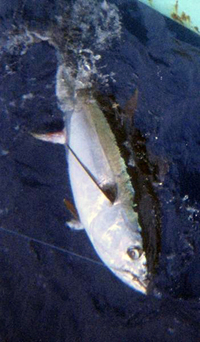
Bigeye tuna tagged with PSAT alongside the Eagle Eye II
Ecology / Biology
Bigeye tuna range throughout the Atlantic, Pacific, and Indian Oceans reaching sizes over 400 lbs and diving to depths greater than 1400 m. Despite the bigeye’s economic importance, very little is understood of bigeye ecology in the Atlantic Ocean, and much of what is known has been extrapolated from fisheries data and studies on bigeye in the Pacific and Indian Oceans. Atlantic bigeye are opportunistic predators, feeding on everything from mackerel, lancetfish, and squid to oceanic lightfish, a midwater, mesopelagic species found in the Gulf of Guinea. Despite the economic and ecological importance of the species as a high tropic level predator, the Atlantic bigeye’s diet remains largely unexplored, and very little in known about their prey choices across vastly diverse regions of this ocean basin.
The largest difference between bigeye and the other tunas is their unique depth preferences and feeding habits. Bigeye have evolved a host of physiological and behavioral adaptations that allow them to feed deep in the water column within the zone of diverse marine organisms that comprise the deep scattering layer (DSL). Bigeye move within the surface waters (less than 50 m) during the night and dive into the depths (approx. 200m – 500 m) during the daylight, following the organisms of the DSL and prey species, such as squid and octopus, that also feed within this layer.
One of the main evolutionary factors driving the development of this unique diving behavior is competition avoidance. The bigeye’s range and habitat overlaps with yellowfin and skipjack tuna, and fishermen often captured these three species at the same time and place. Yellowfin and skipjack, however, spend the majority of their time in surface waters (less than 50 m). The bigeye’s ability to hunt prey in the colder, often oxygen-depleted water of the depths allows them to avoid competition with other tuna species for epipelagic (i.e. surface) prey. In fact, bigeye feeding habits are believed to be more similar to those of swordfish and bigeye thresher sharks, two unrelated species that feed within the DSL, than to any of the other tunas.
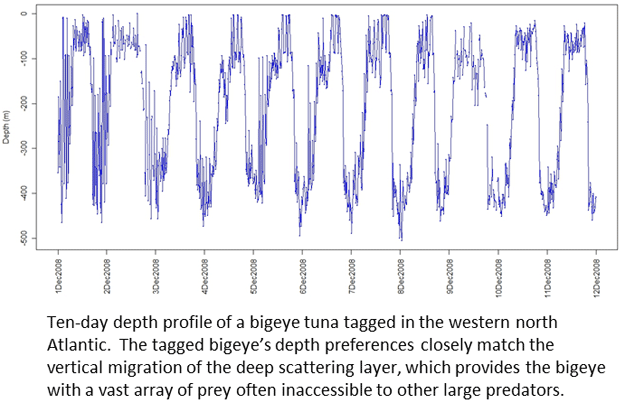
Only two studies have examined the depth preferences of bigeye tuna in the Atlantic. Dr. Matsumoto and his colleagues at the National Research Institute of Far Seas Research found that tropical Atlantic bigeye display similar day/night diving patterns as Pacific bigeye. However, in a study led by Dr. Haritz Arrizabalaga of the AZTI Research Institute and Dr. Jöao Pereira of the University of the Azores with LPRC scientists, bigeye tagged off the Azores with PSATs did not observe the distinct vertical migration patterns commonly seen worldwide, although their findings were limited by short deployment times and small numbers of tagged fish. In the Pacific, various tagging studies have shown that daily vertical migrations represent only one of a variety of behaviors bigeye tuna use to maximize feeding. Atlantic bigeye tuna may similarly adapt their habits to different situations, but the physical and biological factors that trigger these changes are currently unknown.
Bigeye tuna have developed a host of physiological, behavioral, and morphological adaptations in order to follow prey into the cold, dark depths. Like bluefin tuna, bigeye are capable of elevating their internal body temperatures, a phenomenon critical to maintaining normal body processes while escaping predators or pursuing prey. Unlike many of the tropical tunas, bigeyes regularly experience external temperature changes in excess of 68oF, while feeding at depths greater than 300 m during the daylight hours. Such phenomenal changes in temperature are only experienced by the larger and more temperate bluefin tuna.
What allows bigeye to succeed in such a dramatically changing environment, one that none of the other tunas (besides the bluefin) are able to utilize? One adaptation pinpointed by Dr. Lowe of the University of Hawaii is the unique characteristics of bigeye blood. Through a complex system of counter current heat exchangers bigeye blood has both a high oxygen affinity and high capacity for oxygen offloading. This allows bigeye to maintain their metabolic rate (i.e. the ability to feed and escape predators) in cold, oxygen deficient waters. In order to maintain this blood balance, bigeye must keep elevated muscle temperatures throughout their dive. Their counter current heat exchangers are incapable of maintaining these temperatures as bigeye often spend the entirety of daylight hours at depths exceeding 500 m. Thus, bigeye have evolved a curious habit of rapidly ascending into warm surface waters during the daytime in what Dr. Richard Brill of the Virginia Institute of Marine Sciences believe is to “gulp” warm water and maintain proper body temperature.
Bigeye tunas, according to their namesake, also possess an eye specially adapted to low light levels. An average pelagic fish can pick up an object 3 inches in length from a distance of 30 m in surface waters, but at 600 m there is only as much light as on the blackest, starlit night. In order to successfully forage through this darkness, their eyes (among other adaptations) have eyeshine: a reflective surface at the back of the eye called a tapedum. This greatly increases the eye’s sensitivity—a trait also seen in the vision of swordfish and bigeye thresher shark.
Some pelagic species can also adjust how fast the photoreceptors of their eyes receive light, analogous to the adjustment of a camera’s shutter speed. Bigeye eyes, however, are adapted to stay in “night-mode”, appropriate, because bigeye spend most of their time in low light environments.
Life-History
In the Atlantic Ocean, bigeye tuna range from approximately 40°N to 40°S. Bigeye are fished from the Grand Banks of the North Atlantic, across the mid-Atlantic ridge, including the waters of the Azores, to Brazil and the west coast of Africa. The greatest concentrations of fish are often found off Senegal, the Cape Verde islands, and in the Bay of Biscay. Bigeye can travel at upwards of 70 miles/day. In 2010, a single fish tagged on the Grand Banks by the LPRC’s tagging partner Capt. Scott Drabinowicz swam approx. 6,500 miles to the coast of Brazil and back before the tag jettisoned ten months later, only 140 miles from its release location. Other than where these tuna are most commonly intercepted by fisheries, almost nothing is known about the bigeye’s Atlantic-wide migration patterns. Researchers believe that bigeye migrate annually from foraging grounds in the northern and southern hemispheres above 15° of latitude to spawning/foraging areas in equatorial seas.
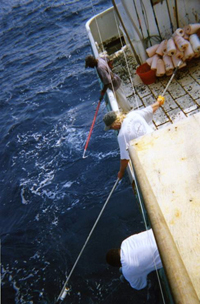
Waiting for the perfect shot to insert the PSAT into a bigeye tuna
The known spawning areas of bigeye tuna are large swaths of ocean spanning the equator from 3°-10° N and S, in waters of high productivity (i.e., along ocean current divergence zones, local upwelling, and eddies) with temperatures greater than 75°F. Researchers believe the largest spawning aggregations occur in the Bay of Biscay (3°-10° S, 5°-15°W), and off Senegal (3°-10° N, 30°-40° W), yet historic larval surveys have found larvae on either side of the equator from Brazil to Africa at various times of the year. Bigeye are multiple batch spawners, capable of spawning every day to every third day while reproductively active. However, it is uncertain how long a single female remains capable of spawning. Bigeye are believed to become sexually mature when they are three to four years old, around 43 - 53 inches in length. This life history statistic, however, has not been verified throughout the Atlantic. Considering the role basic biological information plays in population assessment, further research into age/size-at-maturity is needed.
Examination of ovaries has suggested that fish spawn during the warmest months of the year, or May to August in the Northern hemisphere and December to April in the Southern. This seasonal separation across the equator has led some researchers to believe that there are two populations of bigeye spawning in counter-phase, with mixing occurring in the Bay of Biscay. Genetic analysis conducted by Dr. Elena Gonzalez and colleagues, however, found no evidence of population structure among Atlantic bigeye. While they did observe the presence of two distinct clades, or groups of organisms descended from a common ancestor, there was no geographic structure to the clades distribution. Interesting, one of these clades is absent in the Pacific and Indian oceans, suggesting that the Atlantic population was genetically isolated from other ocean basins during the last glaciation. While the genetic evidence does not support the existence of multiple populations in the Atlantic, the extent to which fish cross the equator, the possibility that fish return to natal spawning areas, and the exact range of the spawning area is still unknown. For example, a single fish tagged by LPRC researchers was at liberty for almost an entire year (except mid-August to mid-October) and never crossed the 40° W meridian into the best-documented spawning region.
Fisheries
Bigeye tuna are currently the most valuable tuna landed by weight worldwide, yet the Atlantic fishery remains one of the least scrutinized by scientists and regulators. Prized for their fatty meat on the global sushi market, the price of bigeye has rapidly increased in recent years, with the prices of the highest quality fish now comparable to those of bluefin tuna. Bigeye are commercially fished in the Indian, Pacific, and Atlantic oceans by pursue seine, longline, and baitboat (predominately in the Eastern Atlantic). Beginning in the 1980’s, there was a drastic increase in bigeye catches due to the rising sushi market and the advent of advanced at-sea freezing technology. While it is not believed that stocks are overfished, research shows an overall stagnation and/or decline in catches in the Atlantic since the late 1990’s, attributed to both a reduction in overall fleet size as well as a reduction in catch rates. On a positive note, regulators believe there has been a potential increase in biomass and a decline in fisheries-related mortality over the last six years. As of 2011, the International Commission for the Conservation of Atlantic Tunas (ICCAT), the managing body for tunas, sharks and billfish in the Atlantic, set the total allowable catch (TAC) at 85,000 tons, a level which they believe will maintain biomass at target levels. U.S. landings usually account for a small fraction of total Atlantic bigeye catches, with landings typically less than 1000 tons/year over the last decade.
Currently longliners target larger (average 88-120 lbs) bigeye fetching higher prices (over 5$/lb) on the Japanese sashimi market. Conversely, the dramatic rise in bigeye catches by purse seiners with the use of fish aggregating devises (FADs) are predominately small fish, in the 10-25 lb size class, that sell for low prices (less that 1$/lb). Such a size disparity has led many to worry that large purse seine catches are undermining the health of the stock. There is also a baitboat fishery in the eastern Atlantic. Baitboats, a ubiquitous name for a variety of fishing techniques utilizing livebait, capture bigeye among various other small to medium sized tunas either by trolling, hand lining, or jackpoling, a method using feathered hooks tied directly to long, fiberglass poles.
Besides commercial longlining, bigeye tuna are also fished recreationally and commercially, using rod and reel, up and down the east coast of the U.S. Targeted by charter and private boats, bigeye are captured along with a host of other offshore game fish from Georges Bank south to the Charlestown Bump. Although more rare there than yellowfin and albacore tuna, bigeye are often captured at night when they move towards the surface chasing prey.

LPRC with our EEII Partners. Left to Right: EEII Captain John Caldwell, LPRC Director Dr. Molly Lutcavage, EEII crew member Darryl Wallace, EEII Captain Scott Drabinowicz, and LPRC Research Assistant Michele Heller
LPRC Research
LPRC scientists have become increasingly focused on bigeye research in the Atlantic over the last few years, being inspired to close major gaps in biological knowledge. Partnering with Captains Scott Drabinowicz and John Caldwell, and crew members of the Eagle Eye II, the LPRC team has been able to release 21 PSAT tags on bigeye since 2008. We, at the LPRC, feel incredibly indebted to our fishermen partners, without whom much of our research on bigeye, along with other species including leatherback turtles, and bluefin tuna, would not be possible. It is through their knowledge and expertise that we are able to tag and study in the far offshore waters that these species often inhabit.
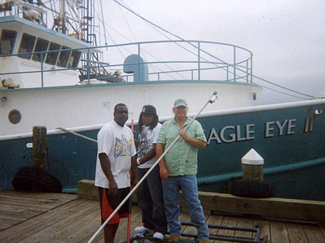
Captain Drabinowicz and tagging crew in front of F/V Eagle Eye II
Of the 21 tags released on bigeye, nine have reported data, two were recaptured, and two are still at large. Days at liberty when data was recorded range from 19-292 days for tagged fish, accounting for over 1,000 days of data on the depth, salinity, temperature, and estimated geographical location of tagged bigeye tuna. Currently, the data collected from these tags are being analyzed in order to examine the migrations, depth preferences, habitat utilization, feeding patterns, and possible breeding habits of the bigeye.
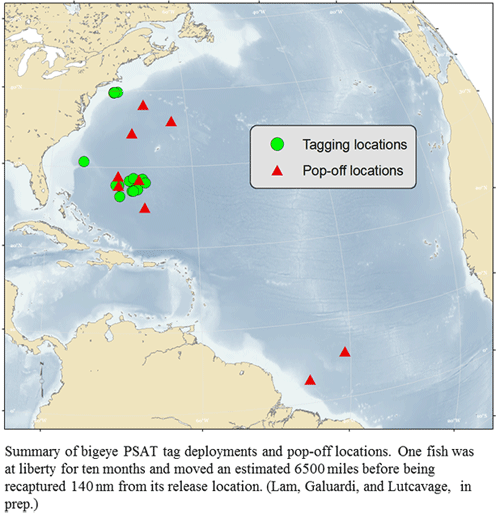
As a high trophic level predator, the bigeye forms an integral aspect of not only our own Atlantic coast’s pelagic ecosystems but those throughout the Atlantic basin. The bigeye tuna’s particular utilization of the prey resources of the deep scattering layer makes it unique among the tunas and puts it in an elite class with the swordfish and bigeye thresher shark, other depth-adapted predators. Yet even today, our understandings of the biological adaptations that allow for such wide ranging behavior is limited at best. With the increasing catches of bigeye from Atlantic waters in recent years, it’s critical that further research into migration patterns and spawning behavior be conducted in order to better inform management decisions for sustainable fisheries and recreational fishing opportunities.
Written by Bart DiFiore
